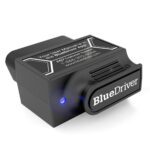Like many, we learned the hard way about car troubles when our van decided to flash its check engine light miles from home. A costly dealer visit later, and still no fix, we realized something had to change. That’s when we invested in our first car diagnostic scanner, a move that quickly pinpointed the real issue – a simple, affordable part replacement.
Modern vehicles, with their intricate electrical and emission systems, can be perplexing. But for those willing to get their hands a little greasy, a car diagnostic scanner offers a powerful way to understand those mysterious dashboard warnings and potentially avoid hefty repair bills.
What Is a Car Diagnostic Scanner?
A car diagnostic scanner, also known as an on-board diagnostics (OBD2) code reader, is essentially a translator between you and your car’s computer. It’s a tool that plugs into your vehicle, speaks the car’s language, and retrieves data about its health and any emerging problems.
Since 1996, OBD2 systems have been mandatory in virtually every car, light truck, SUV, minivan, and hybrid sold in North America. Keith Andreasen, a certified master technician at Innova Electronics, explains, “This system is designed to monitor vehicle systems that can trigger the check engine light, alerting drivers to issues impacting emissions, fuel efficiency, and overall driving performance.”
What Can a Car Diagnostic Scanner Do?
For both DIY enthusiasts and professional mechanics, a car diagnostic scanner is invaluable for troubleshooting vehicle issues. While basic scanners simply read error codes, more advanced models can monitor a wealth of real-time data. Regardless of complexity, all OBD2 devices connect to a standardized port, typically located beneath the steering wheel.
At its core, a scanner reads diagnostic trouble codes (DTCs) generated by your car’s computer. “The scanner interprets these codes and displays them in an understandable format, helping users pinpoint the area of the problem,” Andreasen notes.
Beyond just reading codes, car diagnostic scanners offer a range of functions:
- Clearing Trouble Codes: Once a repair is completed, scanners can clear these codes, turning off the check engine light, tire pressure warning, and other alerts.
- Real-Time Data Monitoring: They provide live readings from various sensors and systems, including engine RPM, vehicle speed, coolant temperature, and oxygen sensor data. This dynamic information is crucial for diagnosing intermittent problems.
- Freeze Frame Data Retrieval: This function captures a snapshot of your vehicle’s system parameters at the exact moment a trouble code was triggered, offering valuable context.
- Live Data Stream Viewing: Advanced scanners can display live data streams from multiple sensors simultaneously, essential for diagnosing complex issues involving interactions between different systems.
- Emissions Readiness Check: Scanners can indicate if your vehicle is likely to pass an upcoming emissions test, saving you potential headaches.
- Vehicle Information Retrieval: Access information like VIN numbers and system calibration details.
- Active Tests (Bi-directional Controls): Some scanners allow you to send commands to your vehicle’s systems to test components, like activating a fuel pump or cycling a solenoid.
- Software Updates: Certain advanced scanners can even facilitate software updates for your vehicle’s computer systems.
What Can’t a Car Diagnostic Scanner Do?
It’s important to have realistic expectations. While incredibly helpful, car diagnostic scanners are not magic wands. Generally, they cannot:
- Physically Repair Your Car: Scanners diagnose issues, but the actual repair work is still up to you or a mechanic.
- Predict All Future Failures: While some databases and apps can offer predictive insights when used with a scanner, they are not foolproof predictors of future problems.
- Diagnose Non-Electrical Issues: Scanners are designed for electrical and electronic system faults. They won’t detect mechanical problems like worn tires, a failing water pump, or contaminated fuel.
- Override Safety Systems: They cannot bypass or alter vehicle safety systems or manufacturer settings.
- Replace Regular Maintenance: Scanners are diagnostic tools, not substitutes for routine maintenance like oil changes and fluid checks.
- Provide Detailed Mechanical Diagnosis: “While scanners highlight problem areas, they may not pinpoint the exact root cause,” Andreasen clarifies. “Further investigation by a skilled mechanic is often necessary for a complete mechanical diagnosis.”
Who Needs a Car Diagnostic Scanner?
A car diagnostic scanner is a powerful asset for anyone who enjoys working on their own car. It empowers you to troubleshoot and potentially fix problems yourself, avoiding labor costs at repair shops.
Andreasen points out, “Even someone with limited car repair experience can use a scanner to assess a vehicle’s readiness for a road trip, check emissions test readiness, or simply understand why the check engine light is illuminated.”
For those considering purchasing a scanner, entry-level options are readily available, as are more advanced models with expanded capabilities. If you’re hesitant to buy, many auto parts stores offer free basic code reading services, providing a no-cost initial diagnosis of your check engine light issue.
By understanding how a car engine diagnostic code scanner works, you gain a valuable tool for car maintenance and repair, putting you back in the driver’s seat when it comes to vehicle health.

